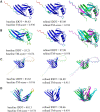Improvement of protein tertiary and quaternary structure predictions using the ReFOLD refinement method and the AlphaFold2 recycling process
- PMID: 37359722
- PMCID: PMC10290552
- DOI: 10.1093/bioadv/vbad078
Improvement of protein tertiary and quaternary structure predictions using the ReFOLD refinement method and the AlphaFold2 recycling process
Abstract
Motivation: The accuracy gap between predicted and experimental structures has been significantly reduced following the development of AlphaFold2 (AF2). However, for many targets, AF2 models still have room for improvement. In previous CASP experiments, highly computationally intensive MD simulation-based methods have been widely used to improve the accuracy of single 3D models. Here, our ReFOLD pipeline was adapted to refine AF2 predictions while maintaining high model accuracy at a modest computational cost. Furthermore, the AF2 recycling process was utilized to improve 3D models by using them as custom template inputs for tertiary and quaternary structure predictions.
Results: According to the Molprobity score, 94% of the generated 3D models by ReFOLD were improved. AF2 recycling showed an improvement rate of 87.5% (using MSAs) and 81.25% (using single sequences) for monomeric AF2 models and 100% (MSA) and 97.8% (single sequence) for monomeric non-AF2 models, as measured by the average change in lDDT. By the same measure, the recycling of multimeric models showed an improvement rate of as much as 80% for AF2-Multimer (AF2M) models and 94% for non-AF2M models.
Availability and implementation: Refinement using AlphaFold2-Multimer recycling is available as part of the MultiFOLD docker package (https://hub.docker.com/r/mcguffin/multifold). The ReFOLD server is available at https://www.reading.ac.uk/bioinf/ReFOLD/ and the modified scripts can be downloaded from https://www.reading.ac.uk/bioinf/downloads/.
Supplementary information: Supplementary data are available at Bioinformatics Advances online.
© The Author(s) 2023. Published by Oxford University Press.
Conflict of interest statement
None declared.
Figures




References
-
- Arantes P.R. et al. (2021) Making it rain: cloud-based molecular simulations for everyone. J. Chem. Inf. Model., 61, 4852–4856. - PubMed
LinkOut - more resources
Full Text Sources
Miscellaneous

